It’s almost winter, and both my chickens have finished their molts just in time for the cooler weather (and what timing — we dropped from a balmy 72°F on Monday to a chilly 57°F today!).
It was an especially trying year for the chickens, since they both suffered from fowl pox at the same time they were molting. The process of regrowing their feathers for winter was already exhausting enough (both of them stopped laying in early fall), but they also went through weeks of fowl pox, which put them in a slump.
Thankfully, they bounced back last week and seem to be their normal selves again… happy, hungry, chatty, and perfectly fluffy.
Kimora went through a hard and intense molt this season, at times looking like she was being prepped for the stew pot. She dropped handfuls of feathers every night, and since new feathers are very fragile and painful as they’re growing out, I couldn’t even comfort her by holding or patting her.
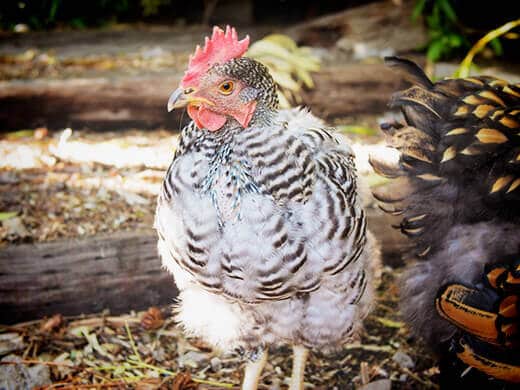
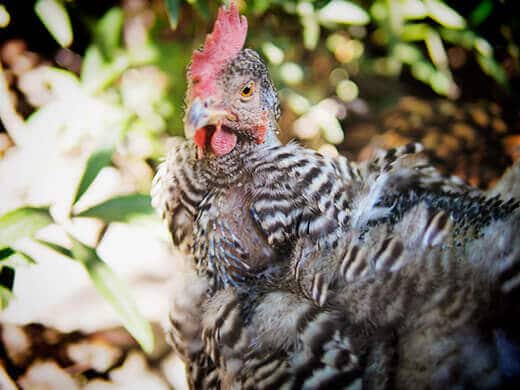
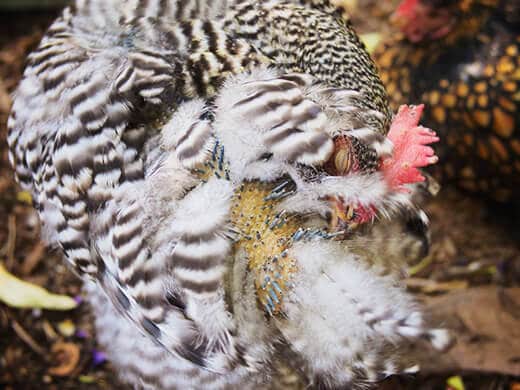
Iman, on the other hand, didn’t even look like she was molting. The only signs I noticed were her normally feathered feet (I call them her Ugg boots) looking a little bare. But she had a soft molt this year, and replaced her old feathers with new ones just as quickly as she was shedding them.
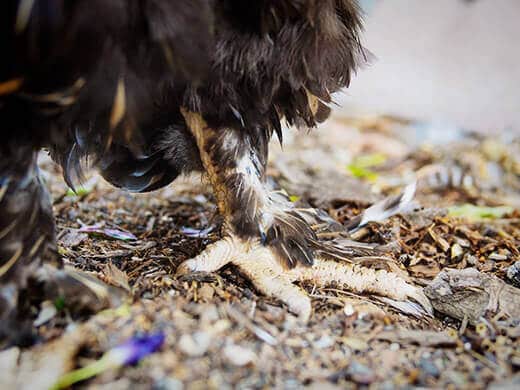
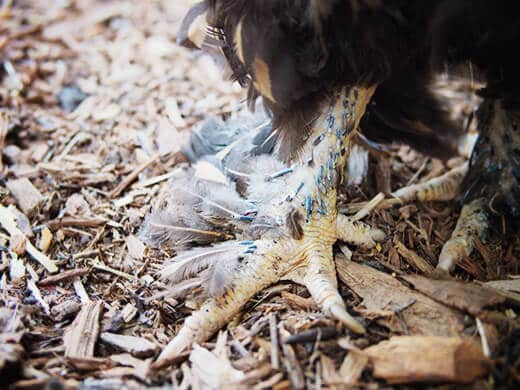
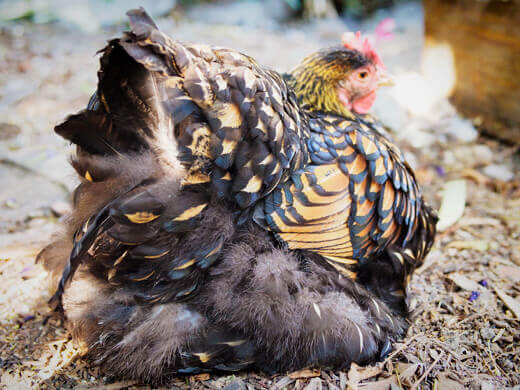
I don’t expect either of them to start laying again until February, when the days become longer. They rest and relax through winter, stocking up their energy for a springtime comeback.
The only change in their diet during this time is a lack of calcium; since they’re not laying eggs, they consume less (or even none) of their crushed oyster shells. Kimora may surprise me with an egg or two some week this winter, as she’s quite the overachiever; but Iman, being the diva she is, demands ample greens and treats with nothing in return. And I’m okay with that.
Some chicken-keepers encourage their flocks to continue laying through winter by simulating daylight, as an increased length of day triggers a hen’s reproductive cycle. They set lights on timers to turn on before sunrise, providing at least 14 to 16 hours of light to induce laying in the darker months.
Installing supplemental light in the coop is a very personal decision and sometimes, it’s a logistical matter. Do you have reliable power to the coop? Do your chickens have an enclosed run where they can safely roam while nighttime predators are still on the prowl? If you have the resources for additional light outside and you can’t bear to be without eggs over winter, altering your flock’s sense of daylight keeps them consistently producing.
The important thing to remember is that chickens must go through a full molt every year in order to maintain their health. Productive layers usually start their molts late and finish early, while poor layers usually start early and finish late.
Molting begins in late summer to early fall, when a decrease in daylight signals a chicken to renew her feathers before the onset of winter. Molting is part of a chicken’s natural life cycle and allows her to rebuild and replenish not only her coat, but also her nutrient reserves.
During a molt, all of a chicken’s energy goes into regrowing thousands of feathers over a period of two to four months. Such a protein-intensive process means a chicken often slows or even stops laying completely while all of her available protein is utilized for feather production. After a molt, her vigor is restored but the seasonal shift means her hormones haven’t kicked into gear yet — and won’t, until the longer days of spring spur her reproductive cycle.
By introducing increased daylight, a chicken-keeper can bypass those four or more months of non-laying or sporadic laying by simulating an early start to spring. The key is supplementing light only in the morning hours before the sun rises, and gradually increasing the hours of light over a few weeks (once your chickens finish molting) to stimulate the pituitary gland into releasing more hormones. When a chicken has been off lay for a while, it may take a month or more for her to start laying again with supplemental light.
But, I feel that’s asking a lot of your flock when your chickens have worked so hard the rest of the year to give you eggs almost daily. After such a physically and mentally draining molt, I let the seasons take over so my chickens can slowly rebuild their energy and fat stores.
I don’t mind the wait if it means they can live as natural a life as possible — waking with the sun, foraging in a pasture, roosting before dark. They eat, they exercise, and come February, I start to find little surprises in the egg box again — which for me, is one more thing to look forward to in spring.


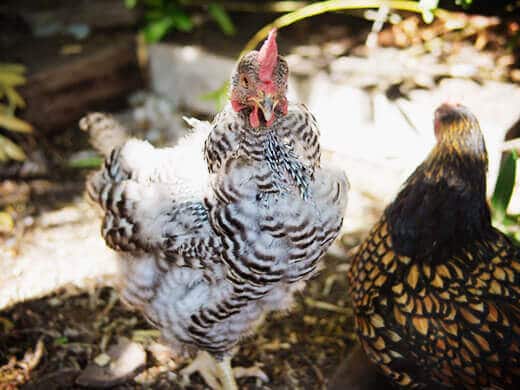













Great piece! I do the same. My hens are my pets; that they lay eggs is just an incidental ‘frosting on the cake’. Typically they stop laying in the Winter months and resume around February or so (I live in the SF so our Winters are extremely mild). Definitely seem triggered by day/light cycle changes. I figure their systems need a rest and when they are ready to lay again, they will. My three hens are getting older now (turn 4 years old in March) but they are a joy to see when I go out to my garden every morning to take care of them. 🙂
I loved your article about the molting chickens. My hens are suffering through it right now. Cat has completed it and she looks like a brand new chicken – beautiful. She’s not laying though and I don’t expect any eggs until spring and the longer days like you said.
I just put out more oyster shells in hopes that my chickens MAY start laying sooner this season. 🙂
Do you simulate daylight in winter to make your chickens start laying again? Making a Case for the Molting Chicken http://t.co/kdVu3Io4a8
Egg laying stops and starts with seasonal shifts. Do you alter it? Making a Case for the Molting Chicken http://t.co/UsKV4sOWR5 #poultry
Your backyard chickens have finished their molts, now what? Making a Case for the Molting Chicken http://t.co/oh06nQPH3K #homesteading
RT @theGardenBetty: What happens after molting season? Making a Case for the Molting Chicken http://t.co/e5eemCZOKW #homesteading #poultry
http://t.co/mxXTNBJ5kK http://t.co/o51CWpWb3N
I let the natural seasons take over and have my hens rest over winter. Making a Case for the Molting Chicken http://t.co/zDUPCJjgiE #poultry
My chickens start laying the first week in January every year.
Lucky you. 🙂 Mine don’t motivate quite so early.
This year will be different. 😉
What happens after molting season? Making a Case for the Molting Chicken http://t.co/e5eemCZOKW #homesteading #poultry
What about chickens that live near the equator? Don’t they lay year round? I know someone who lives in Ecuador. I should ask her. Logic tells me that those hens must lay year round, with their days all the same length.
That’s such an interesting question! And one I’d love to research more.
Since all birds molt, I assume chickens near the equator have their molts triggered by other things. (Here in the US, seasonal molts start with the change in daylight but can also be triggered by changes in diet, stress, environment, etc. in the off season.)
This study http://rspb.royalsocietypublishing.org/content/274/1610/721.full suggests that birds near the equator may be more sensitive to changes in photoperiod. Even though their day length remains 12 hours year-round, there are still wet seasons and dry seasons with changes in the intensity of sunlight that the birds may react to. It would make sense then, that an equatorial bird is adapted to its environment and responds accordingly. And maybe the birds’ biological clocks work in tandem with this?
I do wonder if they continue to lay year-round; maybe their production drops or stops during molt, but they begin laying again right away. I’m guessing that would depend on how sensitive they are to the photoperiod during that season.
Making a Case for the Molting Chicken:
It’s almost winter, and both my chickens have finished their molts jus… http://t.co/v2nW2evEWA